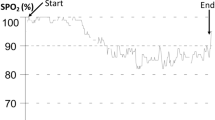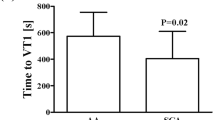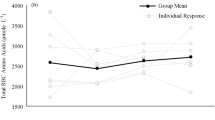Abstract
Red blood cell (RBC) susceptibility to oxidative and osmotic stress in vitro was investigated in cells from trained and untrained men before and after submaximal exercise. Whilst no significant change in peroxidative haemolysis occurred immediately after 1 h of cycling at 60% of maximal aerobic capacity (\(\dot V{\text{O}}_{\text{2}} \) max), a 20% increase was found 6 h later in both groups (P<0.05). The RBC osmotic fragility decreased by 15% immediately after exercise (P<0.001) and this was maintained for 6 h (Ps<0.001). There was an associated decrease in mean cell volume (P<0.05). Training decreased RBC susceptibility to peroxidative haemolysis (P<0.025) but it did not influence any other parameter. These exercise-induced changes were smaller in magnitude but qualitatively similar to those found in haemopathological states involving haem-iron incorporation into membrane lipids and the short-circuiting of antioxidant protection. To explore this similarity, a more strenuous and mechanically stressful exercise test was used. Running at 75%\(\dot V{\text{O}}_{\text{2}} \) max for 45 min reduced the induction time of O2 uptake (peroxidation), consistent with reduced antioxidation capacity, and increased the maximal rate of O2 uptake in RBC challenged with cumene hydroperoxide (P<0.001). The proportion of high-density RBC increased by 10% immediately after running (P<0.001) but no change in membrane-incorporated haem-iron occurred. In contrast, treatment of RBC with oxidants (20–50 μmol·l−1 in vitro increased cell density and membrane incorporation of haem-iron substantially. These results showed that single episodes of submaximal exercise caused significant changes in RBC susceptibility to oxidative and osmotic stress. Such responses may account for the increase in RBC turnover found in athletes undertaking strenuous endurance training.
Similar content being viewed by others
References
Bahr R, Sejersted OM (1991) Effect of intensity of exercise on excess postexercise O2 consumption. Metabolism 40:836–841
Beutler E, Kuhl W, West C (1982) The osmotic fragility of erythrocytes after prolonged liquid storage and after reinfusion. Blood 59:1141–1147
Campwala HQ, Desforges JF (1982) Membrane-bound hemichrome in density-separated cohorts of normal (AA) and sickled (SS) cells. J Lab Clin Med 99:25–28
Chin D, Kuypers F, Lubin B (1989) Lipid peroxidation in human red cells. Semin Hematol 26:257–276
Clark MR (1988) Senescence of red blood cells: problems and progress. Physiol Rev 68:503–553
Clemens MR, Waller HD (1987) Lipid peroxidation in erythrocytes. Chem Phys Lipids 45:251–268
Das SK, Hinds JE, Hardy RE, Collins JC, Mukherjee S (1993) Effects of physical stress on peroxide scavengers and sickle cell trait erythrocytes. Free Radic Biol Med 14:139–147
Duthie GG, Robertson JD, Maughan RJ, Morrice PC (1990) Blood antioxidant status and erythrocyte lipid peroxidation following distance running. Arch Biochem Biophys 282:78–83
Evelo CTA, Palmen NGM, Artur Y, Janssen GME (1992) Changes in blood glutathione concentrations, and in erythrocyte glutathione reductase and glutathione-S-transferase activity after running training and after participation in contests. Eur J Appl Physiol 64:354–358
Follinius M, Brandenberger G (1988) Increase in atrial natriuretic peptide in response to physical exercise. Eur J Appl Physiol 57:159–162
Gohil K, Viguie C, Stanley WC, Brooks GA, Packer L (1988) Blood glutathione oxidation during human exercise. J Appl Physiol 64:115–119
Gore CJ, Scroop GC, Marker JD, Catcheside PG (1992) Plasma volume, osmolarity, total protein, and electrolytes during treadmill running and cycle ergometer exercise. Eur J Appl Physiol 65:302–310
Guglielmini G, Casoni J, Patracchini M, Manfredini F, Grazzi G, Ferrari M, Conconi F (1989) Reduction of Hb levels during the racing season in nonsideropenic professional cyclists. Int J Sports Med 10:352–356
Hebbel RP, Eaton JW (1989) Pathobiology of heme interaction with the erythrocyte membrane. Semin Hematol 26:136–149
Hebbel RP, Ney PA, Foker W (1989) Autoxidation, dehydration, and adhesivity may be related abnormalities of sickle erythrocytes. Am J Physiol 256:C579-C583
Hespel P, Lijnen P, Fiocchi R, Denys B, Lissens W, M'BuyambaKabangu JR, Amery A (1986) Cationic concentrations and transmembrane fluxes in erythrocytes of humans during exercise. J Appl Physiol 61:37–43
Ji LL, Katz A, Fu R, Griffiths M, Spencer M (1993) Blood glutathione status during exercise: effect of carbohydrate supplementation. J Appl Physiol 74:788–792
Kanaley JA, Ji LL (1991) Antioxidant enzyme activity during prolonged exercise in amenorrheic and eumenorrheic athletes. Metabolism 40:88–92
Kuross SA, Rank BH, Hebbel RP (1988) Excess heme in sickle erythrocyte inside-out membranes: possible role of thiol oxidation. Blood 71:876–882
Landaw SA (1988) Factors that accelerate or retard red blood cell senescence. Blood Cells 14:47–67
Mairbäurl H, Humpeler E, Schwaberger G, Pessenhofer H (1983) Training-dependent changes of red blood cell density and erythrocytic oxygen transport. J Appl Physiol 55:1403–1407
Maughan RJ, Donelly AE, Gleeson M, Whiting PH, Walker KA, Clough PJ (1989) Delayed-onset muscle damage and lipid peroxidation in man after a downhill run. Muscle Nerve 12:332–336
Mena P, Maynar M, Gutierrez JM, Maynar J, Timon J, Campillo JE (1991) Erythrocyte free radical scavenger enzymes in bicycle professional racers: adaptation to training. Int J Sports Med 12:563–566
Morse PD, Warth JA (1990) Direct measurement of the internal viscosity of sickle erythrocytes as a function of cell density. Biochim Biophys Acta 1053:49–55
Ohno H, Sato Y, Yamashita K, Doi R, Arai K, Kondo T, Taniguchi N (1986) The effect of brief physical exercise on free radical scavenging enzyme systems in human red blood cells. Can J Physiol Pharmacol 64:1263–1265
Ohno H, Yahata T, Sato Y, Yamamura K, Taniguchi N (1988) Physical training and fasting erythrocyte activities of free radical scavenging enzyme activities in sedentary men. Eur J Appl Physiol 57:173–176
Robertson JD, Maughan RJ, Davidson RJL (1988) Changes in red cell density and related indices in response to distance running. Eur J Appl Physiol 57:264–269
Robertson JD, Maughan RJ, Duthie GG, Morrice PC (1991) Increased blood antioxidant systems of runners in response to training load. Clin Sci 80:611–618
Schmidt W, Maassen N, Trost F, Boning D (1988) Training-induced effects on blood volume, erythrocyte turnover, and haemoglobin oxygen-binding properties. Eur J Appl Physiol 57:490–498
Schmidt W, Maassen N, Tegtbur U, Braumann KM (1989) Changes in plasma volume and red cell formation after a marathon competition. Eur J Appl Physiol 58:453–458
Selby GB, Eichner ER (1986) Endurance swimming, intravascular haemolysis, anemia, and iron depletion: new perspective on athletes anemia. Am J Med 81:791–794
Simmons A (1972) Technical hematology. Lippincott, Philadelphia
Smith JA (1995) Exercise, training and red blood cell turnover. Sports Med 19:9–31
Smith JA, Telford RD, Mason IB, Weidemann MJ (1990) Exercise, training and neutrophil microbicidal activity. Int J Sports Med 11:179–187
Smith JA, Baker MS, Weidemann MJ (1992) Free radical generation in hydroperoxide-treated erythrocytes monitored continuously by luminol-amplified chemiluminescence. Biochem Int 28:1009–1020
Snyder LM, Sauberman N, Condara H, Dolan J, Jacobs J, Szymanski I, Fortier NL (1981) Red cell membrane response to hydrogen peroxide-sensitivity in hereditary xerocytosis and in other abnormal red cells. Br J Haematol 48:435–444
Snyder LM, Leb L, Piotrowski J, Sauberman N, Liu SC, Fortier NL (1983) Irreversible spectrin-haemoglobin crosslinking in vivo: a marker for red cell senescence. Br Haematol 53:379–384
Staubli M, Roessler B (1986) The mean red cell volume in long distance runners. Eur J Appl Physiol 55:49–53
Van Beaumont W, Rochelle RH (1974) Erythrocyte volume stability with plasma osmolarity changes in exercising man. Proc Soc Exp Biol Med 145:240–243
Vettore L, De Matteis MC, Zampini P (1980) A new density gradient system for the separation of human red blood cells. Am J Hematol 8:291–297
Weight LM, Byrne MJ, Jacobs P (1991) Haemolytic effects of exercise. Clin Sci 81:147–152
Wilkerson JE, Gutin B, Horvath SM (1977) Exercise-induced changes in blood, red cell, and plasma volumes in man. Med Sci Sports 9:155–158
Winterbourn CC (1983) Reactions of superoxide with hemoglobin. In: Greenwald RA (ed) CRC handbook of methods for oxygen radical research. CRC Press, Boca Raton, Fla., pp 137–141
Zamir N, Tuvia S, Riven-Kreitman R, Levin S, Korenstein R (1992) Atrial natriuretic peptide: direct effects on human red blood cell dynamics. Biochem Biophys Res Comm 188:1003–1009
Author information
Authors and Affiliations
Rights and permissions
About this article
Cite this article
Smith, J.A., Kolbuch-Braddon, M., Gillam, I. et al. Changes in the susceptibility of red blood cells to oxidative and osmotic stress following submaximal exercise. Europ. J. Appl. Physiol. 70, 427–436 (1995). https://doi.org/10.1007/BF00618494
Accepted:
Issue Date:
DOI: https://doi.org/10.1007/BF00618494




